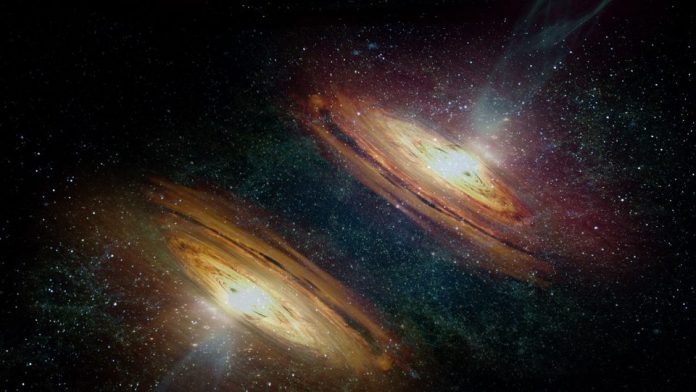Astronomers using the MeerKAT radio telescope at the South African Radio Astronomy Observatory in Cape Town, South Africa, have discovered two new radio galaxies with sizes of more than 6.5 million light-years, or 62 times larger than the Milky Way.
Some classes of active galactic nuclei have jets of relativistic plasma and particles emanating from the central region, which produce radio emission.
In some cases, these jets propagate to extremely large distances beyond the host galaxy and into the intergalactic medium.
When the projected size of these jets and lobes exceeds 2.3 million light-years, such systems are referred to as giant radio galaxies.
These galaxies are the largest individual objects in the Universe. The largest known has a projected size of 15.9 million light-years, though the majority of known giant radio galaxies are below 6.5 million light-years in extent.
“In the past, this population of galaxies has been hidden from our ‘sight’ by the technical limitations of radio telescopes,” said lead author Dr. Jacinta Delhaize, an astronomer in the Department of Astronomy at the University of Cape Town.
“However, it is now being revealed thanks to the impressive capabilities of the new generation of telescopes.”
The two new giant radio galaxies, named MGTC J095959.63+024608.6 and MGTC J100016.84+015133.0, were spotted in radio maps created by the MeerKAT International GHz Tiered Extragalactic Exploration (MIGHTEE) survey.
“The MeerKAT telescope is the best of its kind in the world,” said co-author Dr. Ian Heywood, an astronomer in the Department of Physics at the University of Oxford, the Department of Physics and Electronics at Rhodes University, and South African Radio Astronomy Observatory.
“We have managed to identify these giant radio galaxies for the first time because of MeerKAT’s unprecedented sensitivity to faint and diffuse radio light.”
“We found these giant radio galaxies in a region of sky which is only about 4 times the area of the full Moon,” Dr. Delhaize said.
“Based on our current knowledge of the density of giant radio galaxies in the sky, the probability of finding two of them in this region is less than 0.0003%.”
“This means that giant radio galaxies are probably far more common than we thought!”
“These two galaxies are special because they are amongst the largest giants known, and in the top 10% of all giant radio galaxies,” said co-author Dr. Matthew Prescott, an astronomer in the Inter-University Institute for Data Intensive Astronomy and the Department of Physics and Astronomy at the University of the Western Cape.
“They are more than 6.5 million light-years across. Yet they are fainter than others of the same size.”
“We suspect that many more galaxies like these should exist, because of the way we think galaxies grow and change over their lifetimes.”
The discovery is reported in a paper in the Monthly Notices of the Royal Astronomical Society.








